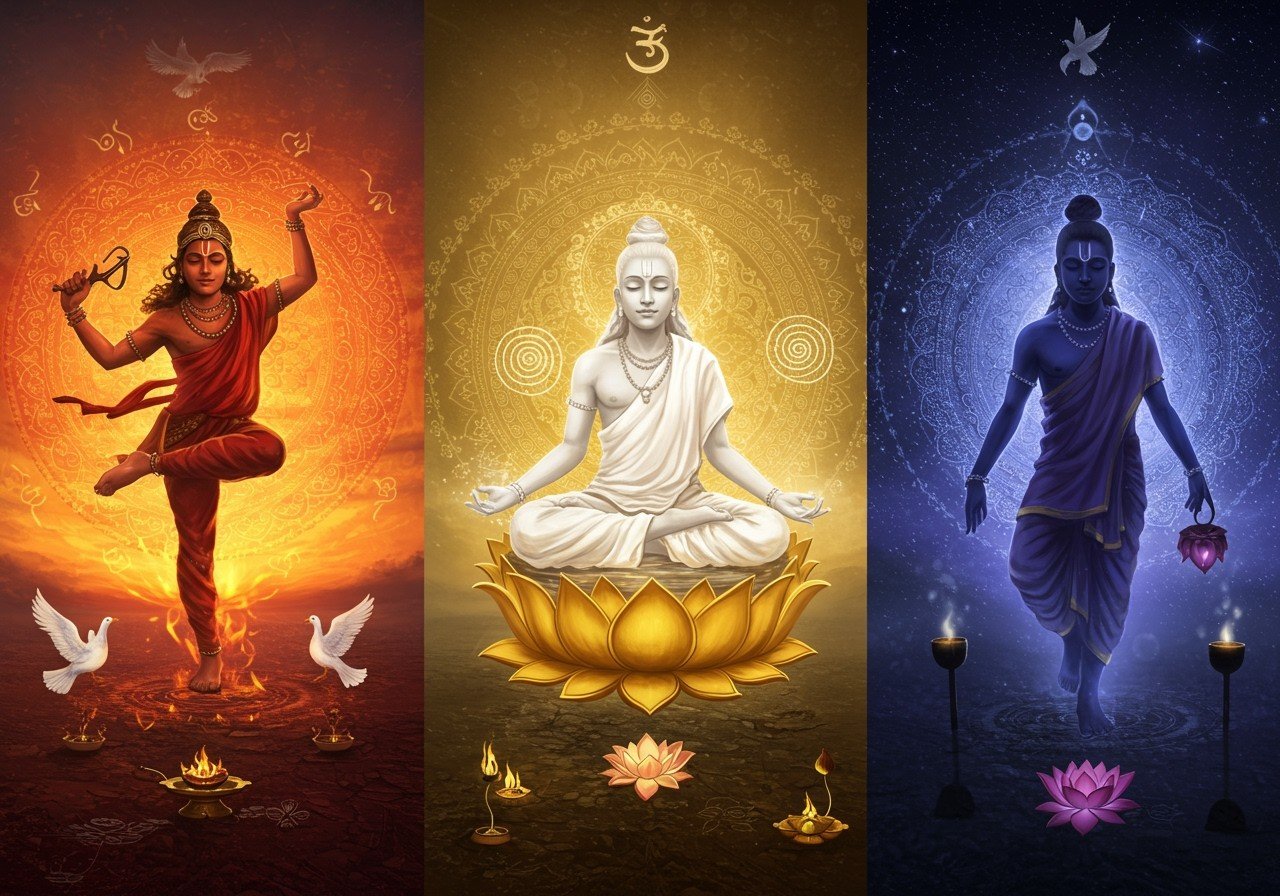
In Hindu philosophy, the concept of ‘Guna’ plays a vital role in understanding the qualities that shape human nature and the universe. Derived from the Sanskrit word meaning ‘quality,’ ‘attribute,’ or ‘property,’ Guna represents three fundamental qualities present in varying degrees within every individual and object. These qualities—Sattva (purity, goodness), Rajas (passion, activity), and Tamas (inertia, darkness)—influence personal growth, behavior, and spiritual development. Exploring the nature of Gunas offers a pathway to a more balanced and fulfilling life. Poojn.in, India’s leading store for cultural goods and services, provides insights into this essential concept.
Introduction to the Gunas
Guna is a cornerstone of Hindu thought, illuminating the diverse qualities that define human nature and the cosmos. The term ‘Guna’ originates from the Sanskrit word meaning ‘quality,’ ‘peculiarity,’ ‘attribute,’ or ‘property’. Hinduism identifies three fundamental Gunas: Sattva, Rajas, and Tamas. Understanding these Gunas can offer valuable guidance for personal and spiritual growth. They are essentially the threads that weave together the fabric of reality, influencing everything from our personalities to our experiences.
- Sattva: This Guna embodies purity, goodness, light, calmness, and harmony. It is linked to wisdom, balance, and spiritual enlightenment. Sattva brings a sense of peace, clarity, and understanding.
- Rajas: This Guna signifies passion, activity, energy, and movement. It fuels ambition, change, and the pursuit of goals. Rajas is the driving force behind action and creativity, but in excess, it can lead to restlessness.
- Tamas: This Guna embodies inertia, darkness, ignorance, laziness, and destruction. While it provides stability, an overabundance of Tamas can result in stagnation, confusion, and negativity. Transforming Tamas energy into positive habits can lead to growth.
These three Gunas exist in everyone and everything in varying proportions. Recognizing the interplay of these Gunas within us can provide valuable insights into our personalities, behaviors, and potential for growth.
Delving Deeper into the Three Gunas
In Hindu philosophy, the concept of ‘Guna’ offers a profound understanding of the qualities governing both the universe and individual lives. Rooted in Samkhya philosophy, ‘Guna’ represents the fundamental components of reality, manifesting as Sattva, Rajas, and Tamas. Each Guna plays a unique role in shaping our nature and experiences.
Sattva: Embracing Purity and Harmony
Sattva is the quality of purity, harmony, wisdom, light, calmness, and balance. Picture a serene morning filled with birdsong and a gentle breeze—this is Sattva in action. When Sattva is dominant, it cultivates clarity, calmness, and inner peace. This leads to joy, knowledge, and spiritual growth. It’s important to note that while Sattva is associated with positive qualities, excessive attachment to it can hinder progress by creating an over-reliance on happiness and wisdom.
Rajas: The Dynamism of Activity
Rajas embodies activity, passion, energy, movement, and dynamism. Think of it as the driving force that propels you toward goals and action. Rajas fuels ambition, change, and the continuous pursuit of progress. While essential for achieving goals, an excess of Rajas can result in restlessness, anxiety, and stress. Finding balance with this energy helps in achieving objectives without feeling overwhelmed.
Tamas: The Grounding Force of Inertia
Tamas represents inertia, darkness, ignorance, laziness, stability, and destruction. Like the night that brings rest, it can also bring confusion if left unchecked. Tamas, while often viewed negatively, provides necessary stability and grounding. However, too much Tamas leads to laziness, ignorance, and resistance to change. By understanding and transforming Tamas energy into constructive habits, we can foster growth and stability.
Guna and Self-Discovery
Understanding your dominant Guna can be a powerful tool for self-awareness. Self-reflection, meditation, and guidance from mentors can help you identify your predominant Guna. Recognizing how external factors—diet, environment, relationships—influence these qualities is crucial for personal growth. Balancing the Gunas aligns your life with personal and spiritual aspirations.
Guna in Relationships
Gunas have traditionally played a significant role in Hindu matchmaking. The balance of Gunas between partners is believed to influence marital harmony. Sattva is highly valued for fostering mutual understanding and peace. Kundali matching, an ancient practice, assesses these qualities for compatibility. This tradition adapts to modern relationships while honoring ancient wisdom.
The Role of Gunas in Spirituality
On a spiritual journey, the Gunas hold immense importance. Cultivating Sattva enhances practices like meditation and yoga, creating a conducive environment for inner peace. Addressing the challenges presented by Rajas and Tamas through discipline paves the way for spiritual progress. Ancient texts like the Bhagavad Gita offer profound insights into transcending the Gunas to attain higher states of consciousness.
Integrating Gunas into Daily Life
Applying the principles of Gunas to everyday life fosters a sense of balance and harmony. Enhance Sattva through mindful living, healthy habits, and positive environments. Manage Rajas for optimal work-life balance and focused action. Transform Tamas into productive routines and grounded stability. Being mindful of the Guna dynamics helps navigate modern life’s complexities with greater ease and awareness.
For devotees of Laddu Gopal, understanding the significance of Gunas can deepen your spiritual practice. Explore our exquisite collection of Laddu Gopal Murtis at poojn.in. These sacred statues serve as a focal point for devotion and offer a tangible connection to the divine.
Exploring the Essence of Sindoor
Sindoor holds profound cultural and religious significance in Hindu traditions. At Poojn.in, we recognize the sanctity of this vermillion powder, offering pure and traditional options for both matrimonial and religious purposes. Traditionally, Sindoor was made from natural ingredients like turmeric and alum, resulting in a safe and non-toxic red powder. While commercial versions often use synthetic materials, we prioritize authenticity and quality.
Sindoor serves multiple purposes:
- Symbol of Marriage: Sindoor signifies a woman’s marital status and commitment.
- Devotional Offering: Used in the worship of goddesses like Shakti and Lakshmi.
- Auspicious Element: Plays a vital role in various religious ceremonies and rituals.
Explore our premium Sindoor collection at Poojn.in. We offer various options, including natural Kumkum Sindoor, ready-to-use liquid Sindoor, and premium quality powder Sindoor, catering to both traditional practices and modern convenience.
Further explore the rich tapestry of Hindu traditions with our articles on Lord Ganesha’s various forms and Goddess Lakshmi’s significance.
Embracing the Journey of the Gunas
By embracing the wisdom of the Gunas, we embark on a journey of self-discovery and deeper connection with the world. This journey encourages balance, harmony, and understanding in every facet of life. Whether navigating personal growth, relationships, or spiritual practices, the Gunas provide guidance and insight. As we face modern challenges, the timeless teachings of Sattva, Rajas, and Tamas offer a path toward peace, clarity, and fulfillment. With awareness and intention, we can honor ancient traditions while creating a future enriched with balance and wisdom. You can find various resources and products related to Hindu traditions and practices at poojn.in.


